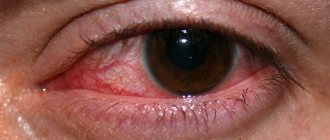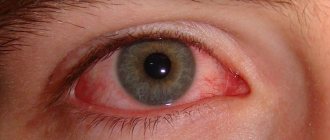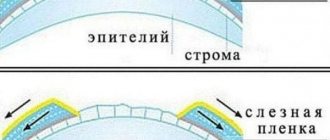In the modern world, there are various diseases of the organs of vision, which are sometimes very difficult to combat. A disruption of the normal structure of the vitreous body of the eye, in which it loses its transparency, is called destruction of the fibers of the reticular structure of this part of the visual organ. This condition is characterized by such manifestations as blurred vision, dots and spots flickering in front of the eye.
At first, these manifestations may not even affect the quality of life. However, without proper treatment, destruction can only intensify. This will lead to serious visual impairment. Often such processes occur against the background of age-related changes, as well as under the influence of a number of negative factors. To identify the exact causes of destruction, it is worth undergoing a comprehensive examination.
How is cloudiness of the eye body treated? Destruction can be reduced using folk remedies. This therapy is considered safer than traditional medicine. Folk remedies help restore vitreous tissue and normalize blood circulation in the eyeball. Using these procedures helps slow down the process of vision deterioration. In this review, we will look at the main treatment methods and their effectiveness.
Description of the problem
What can be said about the vitreous humor of the eye? This is one of the most important parts of the human visual system. Passing through it, light rays are fixed on the lens. 99% of the vitreous body consists of liquid. The rest is organic structural elements. The vitreous body in a healthy person should be completely transparent. Rays of light must pass through it unhindered. However, age-related changes and exposure to negative environmental factors can lead to loss of vitreous clarity. As a result, opaque elements appear, which are visually perceived as clouding in the eyes, flies or threads.
Why does my vision become cloudy?
Periodic blurred vision can be the result of increased blood pressure, eye strain, dry eye syndrome, or hypoglycemia, in which the blood glucose level drops. Visual fatigue often occurs during prolonged work at a computer, microscope, or when exposed to ultraviolet radiation. A sharp jump in pressure often occurs when quickly lifting, bending and turning the head. Cloudiness in only one eye often indicates ophthalmological diseases such as glaucoma and conjunctivitis.
Short-term clouding, followed by a headache, can be caused by a number of factors and diseases, namely:
- changes in weather conditions, including changes in atmospheric pressure;
- oxygen starvation;
- stress;
- overwork, fatigue;
- nervous exhaustion;
- hypovitaminosis;
- spinal injuries;
- concussion;
- cervical osteochondrosis;
- cardiovascular pathologies.
Migraine can also be the cause of blurred vision. This disease is characterized by pain in one side of the head, which is accompanied by nausea and ripples in the eyes. Therapy begins with taking analgesic drugs that help you come to your senses.
A person should immediately consult an ophthalmologist if fog appears in the eyes, especially in the following cases:
- the presence of pain, photophobia and lacrimation;
- when trying to see an object, dizziness, double vision and headache appear;
- a sharp decrease in visual acuity;
- a history of arterial hypertension or diabetes mellitus.
Development of the disease
Typically, destruction of the vitreous body of the eye occurs from its central region. At the initial stage of the disease, a cavity is formed, which is filled with opaque fibers of organic origin. The structure of the vitreous body itself changes. As a result, conglomerates of tissue particles appear, which causes clouding of the eye lens. Developing destruction can provoke retinal detachment and wrinkling of the vitreous body. This in turn will cause significant visual impairment, in some cases the person will lose it completely.
Reasons for the development of turbidity
One of the reasons for the development of cataracts is a change in the biochemical composition of the lens. During life, eye tissue accumulates substances that can change the cellular structure and functionality of the organ of vision. Over the years, control over DNA replication errors weakens, which provokes the replacement of healthy cells with defective cellular elements. However, age is not the only prerequisite for the development of pathology.
Causes of clouding of the lens of the eye :
- hormonal imbalance, which serves as the basis for the accumulation of atypical substances in the eyeball;
- lack of vitamins (deficiency of vitamins A, B, PP), slow metabolism, impaired metabolic processes in the body;
- cumulative effect from excessive intake of pharmacological agents;
- excess sun throughout life, which provokes increased formation of free radicals;
- bad habits, alcohol addiction, smoking, taking drugs.
Despite a very specific list of reasons, it is impossible to completely protect yourself from the appearance of cataracts. Age-related changes are inevitable. Statistics show that by the age of 80, almost every person will be diagnosed with cataracts.
Causes
Why does blurred vision occur? The reasons for such destructive changes may be as follows:
- chronic eye diseases;
- involution;
- farsightedness;
- myopia;
- dystrophic processes;
- glaucoma and increased intraocular pressure;
- osteochondrosis of the cervical vertebrae;
- helminthic infestation;
- head injuries;
- metabolic disorders;
- psycho-emotional disorders;
- lack of nutrients and vitamins in the diet.
It is worth noting that two large groups of vitreous destruction can be distinguished:
- Damage due to trauma.
- Insufficient nutrition of the eye tissues, leading to structural disorders of the body.
As a rule, changes of this kind occur in people over 40 years of age. Also, the risk of such disorders is much higher among citizens suffering from farsightedness, myopia and other vision pathologies. First of all, this is due to the fact that these diseases lead to disturbances in the blood supply to the eye tissues. This can significantly accelerate the development of destructive changes.
What does cloudiness in the eyes mean?
Cloudiness in the eyes is a loss of visual acuity. At the same time, all objects appear blurry and out of focus. This may be the result of a sleepless night, fatigue, severe emotional distress, or eye disease. In this case, clarity of vision is lost.
Symptoms
Hazy or cloudy vision can affect the entire field of vision or specific areas. The blurred image can be not only in the central part, but also along the periphery of your field of vision.
In some cases, other eye and general symptoms may appear
• eye pain • headache • nausea • dizziness • flashes of lightning or rainbow circles before the eyes • floating cobwebs or floaters before the eyes
Causes
There are the following reasons for the appearance of this symptom:
1. Refractive errors. Eye diseases such as nearsightedness, farsightedness or astigmatism cause cloudy vision. It goes away completely when wearing glasses or contact lenses, or after laser refractive surgery. 2. Corneal opacities. Opacities in the cornea occur from injury or inflammation. Where the cornea becomes cloudy, the image becomes fuzzy or cloudy.
3. Cataract. The appearance of cloudiness in the eyes due to cataracts develops gradually. As the severity of cataracts increases, vision progressively decreases.
4. Glaucoma. Blurred vision or “tunnel vision” can occur with glaucoma. In glaucoma, the optic nerve stops working fully, causing blurred images and loss of visual fields. 5. Age-related macular degeneration. Degeneration of the retina in the central zone leads to decreased vision and loss of the ability to distinguish small details.
6. Opacities in the vitreous body. Loss of transparency of the vitreous leads to the appearance of the symptom of cloudiness in the eyes.
7. Migraine. With migraine, during an attack there may be changes in vision, blurred images or loss of visual fields.
8. Pregnancy. During pregnancy, even with excellent vision, cloudiness in the eyes may periodically appear. This is due to hormonal changes in the body. In this case, after childbirth, all symptoms disappear
9. Visual syndrome If cloudiness in the eyes comes and goes, this may mean the development of eye fatigue. It occurs from overwork, overexertion or intense exposure to sunlight.
10. Wearing contact lenses. If you use soft contact lenses incorrectly, your eyes may become cloudy. This is due to the presence of deposits in the lenses themselves.
When should you see a doctor urgently?
If the feeling of cloudiness in the eyes is accompanied by the following symptoms:
• is accompanied by a severe headache • problems with speech appear or it is difficult for you to say what you want • vomiting and dizziness appear • you have a history of hypertension and diabetes mellitus. • loss of muscle control appeared on one side of the body • along with cloudiness in the eyes, double vision appeared, speech impairment appeared
Treatment or what to do if your eyes are cloudy
If cloudiness appears in your eyes, you should immediately consult a doctor to find out the cause. Wearing glasses or contact lenses helps with nearsightedness, farsightedness or astigmatism. People who are not satisfied with glasses or contacts can benefit from laser vision correction.
Decreased vision in the eyes due to cataracts and glaucoma can be treated with surgery.
Age-related macular degeneration requires conservative treatment and constant monitoring by an ophthalmologist.
If cloudiness in the eyes is caused by a general disease (arterial hypertension, vascular diseases or a brain tumor), then the problem in the eyes will go away and decrease only with treatment of the underlying disease.
In diabetes mellitus, cloudiness in the eyes may be the result of low blood sugar or swelling and hemorrhages in the retina. In this case, urgent consultation with an ophthalmologist and endocrinologist is necessary.
What should you absolutely not do?
If cloudiness appears in your eyes, you should not:
• instill eye drops without a doctor’s prescription • wear contact lenses • choose your own glasses without consulting a doctor • take medications without consulting a doctor
What happens if the symptom is not treated?
If cloudiness in the eyes is not treated for diseases such as cataracts, glaucoma or macular degeneration, corneal diseases, then vision will progressively deteriorate, leading to blindness.
Preventing blurred vision
Here are some tips to help you avoid cloudy eyes:
• Visit your eye doctor regularly to ensure early diagnosis of conditions that may be causing cloudy eyes • Always wear sunglasses in the summer. • If you wear contact lenses, wash your hands before putting or removing your contact lenses to reduce the risk of eye infection. • If you have a history of hypertension and diabetes mellitus, be sure to visit an eye doctor once every 6 months • Wear safety glasses when working with equipment.
Come for a diagnosis at the Kazakh Research Institute of Eye Diseases at the address: Almaty, Tole bi street, 95a (corner of Baitursynov street). Telephone; +7 (727) 279 54 36
Destructive processes
In medicine they are divided into several types.
Namely:
- Filamentous destruction: a person in this condition may experience blurred vision and dizziness. It seems as if threads are stretched in front of the eye. Destruction of this type usually develops as a result of age-related changes in people suffering from myopia. During a detailed examination, a doctor can detect fibers of organic matter between the cornea and retina. The vitreous body takes on a more liquid consistency.
- Granular destruction: at this stage, vision becomes blurred and its sharpness decreases. It’s as if drops of water are constantly visible in front of my eyes. As a rule, this disease develops as a result of a prolonged infectious process, as well as due to systemic disturbances in the functioning of the body. Destructive processes in the vitreous body can cause the formation of small conglomerates of organic matter.
- Crystal destruction: extremely rare. It occurs due to the high content of substances such as cholesterol, amino acids, and so on in the vitreous body.
Types of lens opacities
To find out how a person with cataracts sees the world, imagine looking into the distance through a running stream of water. It’s as if you are standing on one side of a waterfall, and what interests you is on the other side. It is unlikely that under these conditions you will be able to view objects with a high degree of clarity. So the eye with cataracts perceives surrounding objects as if through a thick film.
Clouding of the lens gradually causes a change in the pupil of the eye, in which it becomes whitish rather than black. Such transformations are irreversible, but it is still possible to stop the progression of destructive processes.
There are several types of cataracts:
- Age-related - develops in adulthood, mainly after 50 years.
- Congenital type - a child is born with this form of disorder, and manifestations of the disease occur in the early stages of life.
- Traumatic - pathology arises after blows, bruises, mechanical and chemical damage.
- Radiation - this form of cataract is extremely rare and is caused by exposure to background radiation.
Symptoms
Are eye pain, blurred vision and visual disturbances always signs of destruction? After all, similar signs also appear with atherosclerosis of blood vessels, various ailments of the nervous system, disorders of the blood supply to the brain, and so on. To correctly determine the cause of unpleasant symptoms and prescribe adequate treatment, the doctor must conduct an accurate differential diagnosis.
The following symptoms are most characteristic of this disease:
- flashes and lightning before the eyes;
- threads, spots, “black flies”;
- blurred vision, especially when looking at bright lights or white objects.
It is worth noting that different degrees of destruction are characterized by different symptoms. If its signs are expressed quite clearly, then this may indicate a serious pathology. If left untreated, this condition can lead to irreversible changes in the structure of the lens and even blindness.
Vision: 10 symptoms that should scare you
Medical center of the highest category AILAZ
To paraphrase a well-known expression, alas, all organs are submissive to old age - this is true, and the eyes are no exception. Over the years, the eyes can be affected by age-related cataracts or retinal dystrophy... To avoid loss of vision or other possible threats, you need to be regularly examined by an ophthalmologist - this is the only way to protect your eyes.
There are vision diseases, such as, for example, an acute attack of glaucoma - when the clock counts: the sooner you see a doctor, the greater the chance of preserving your vision. So, what are the most dangerous signs of visual impairment?
1. Sharp deterioration of vision in one eye
If you have already passed the 60th birthday and if you have at least one of the listed diseases: myopia, hypertension, diabetes mellitus, there is a high risk that vision loss is caused by vascular disorders. In this case, emergency medical care is necessary - consult a doctor as soon as possible!
2. The feeling of a black curtain in front of the eyes that covers some part of the field of vision
This is a serious symptom that is often observed with retinal detachment. Here, as in the previous case, the sooner you start treatment, the greater the chance of keeping your eyes healthy.
3. Sharp pain in the eye, redness, blurred vision, possibly nausea, vomiting
This is how an attack of angle-closure glaucoma can occur. Intraocular pressure rises sharply, and this can damage the optic nerve. There is an urgent need to reduce intraocular pressure, including surgical treatment. This will not go away on its own; you need to see a doctor.
4. Gradual or sudden narrowing of the field of view
If your field of vision gradually narrows, over time you will only be able to see what is directly in front of you. This is called “tubular” vision and may indicate glaucoma: a narrowing of the visual field due to damage to the optic nerve is one of its main signs. Treatment is also necessary here, otherwise vision will deteriorate.
Glaucoma is an insidious disease and often patients are not aware of its existence. the AILAZ medical center you will find a questionnaire for self-diagnosis of glaucoma .
5. Gradual deterioration of central vision, blurred, unclear image (straight lines look wavy, curved)
This may indicate a disease in the central region of the retina - the macula, which is essentially responsible for normal vision. This disease is age-related - older people are often susceptible to it. Glasses do not help; without treatment, vision steadily declines. Today, there are many treatment options depending on the form of macular degeneration.
Another reason for a sudden decrease in vision is a retinal tear in the central zone. If you do not immediately contact an ophthalmologist and begin treatment, your vision is unlikely to be restored.
6. When everything in front of your eyes is as if in a fog, the brightness and contrast of vision decreases
Thus, cataracts can develop, causing clouding of the lens. In this case, vision decreases gradually, down to the ability to only distinguish light. Here we are talking about planned surgical intervention - removal of cataracts followed by implantation of an artificial lens. At the same time, it is worth seeing an ophthalmologist, since sometimes cataracts cause intraocular pressure, and this is an indication for urgent surgical treatment. In addition, cataracts cause the lens to enlarge and harden, which can make it difficult to remove—another reason to visit your eye doctor regularly: to avoid wasting time.
Modern technologies make it possible to remove a cataract and replace it with a transparent artificial lens painlessly and in a matter of minutes. You don't have to endure the discomfort of blurred vision. Decide to undergo examination and surgery.
7. Dark spots, partial opacities, feeling of fog or haze before the eyes
If a patient suffers from diabetes, the likelihood of eye damage is quite high, and the longer the diabetes period, the more likely changes in the eye are. Regular visits to an ophthalmologist are mandatory. If necessary, the ophthalmologist will prescribe complex treatment: not only appropriate medications, but often laser treatment. Timely treatment will allow you to preserve your vision.
8. A burning sensation, sand in the eyes, a sensation of a foreign body, lacrimation or, conversely, a feeling of dryness
This is a typical description of dry eye syndrome, the symptoms of which can worsen with age. As a rule, this disease does not cause any particular danger to vision, but severe dry eye syndrome can cause some pathological conditions. An experienced ophthalmologist will conduct the necessary examination and prescribe moisturizing drops.
the AILAZ medical center you will find a questionnaire for self-diagnosis of dry eye syndrome .
9. When the image appears double
When you see double, there can be several reasons, and it is not necessarily a “visual” problem. The reason for this may be intoxication, vascular disorders, diseases of the nervous system, pathology of the endocrine system. If double vision appears, it is better to immediately be examined by several doctors: a therapist, an ophthalmologist, a neurologist and an endocrinologist.
10. Floaters before the eyes
As a rule, floating spots, threads, “spiders” before the eyes are caused by destruction of the vitreous body. This is due to age-related changes in its structure and does not cause danger. With age, the vitreous body loses its density, liquefies and does not fit as tightly to the retina as before. When its fibers stick together and lose transparency, they cast a shadow on the retina and are perceived as defects in the visual field. This is clearly visible on a white background: snow, a sheet of paper. Destruction of the vitreous body can be caused by arterial hypertension, cervical osteochondrosis, diabetes mellitus, injuries to the head, eyes and nose.
At the same time, a spot that suddenly appears before the eyes, a “curtain,” may be the result of a serious pathology that requires surgical treatment, for example, hemorrhage in the retina or vitreous body. If symptoms appear suddenly, within one day, immediately consult an ophthalmologist.
In any case, it is important to remember: if unknown visual symptoms occur, it is better to immediately consult an ophthalmologist. If your vision has deteriorated sharply - over a few days or even hours, or pain bothers you, do not waste time. Even if you cannot consult your doctor, you can go to an emergency eye care office, which is located in every city. As a last resort, many optician stores have competent ophthalmologists who will conduct an initial diagnosis and advise further actions.
Ask an ophthalmologist a question
Address: 02140, Ukraine, Kiev, Bazhana Ave., 12a, right wing, 5th floor. Telephone: Free hotline from a landline phone in Ukraine: 0.
Risk of surgery
How to overcome clouding of the lens of the eye? Treatment usually involves surgery. This method is becoming increasingly popular every year. However, everything is not so simple here. The operation can lead to much more serious complications. In addition, in most cases, vision begins to decline again after such manipulation. But the main disadvantage of this method is that lenses and glasses do not work on the operated eyes. As a result, the patient begins to have vision problems, and he cannot do anything about it.
Diagnosis of lens opacities
The diagnostic base at Dr. Trubilin’s clinic is very wide. Thanks to new equipment, doctors can detect even minor changes in the structure of the eyeball. If a cataract is suspected, a complex of instrumental studies is carried out, during which the following diagnostic methods are used:
- Ophthalmometry - the doctor examines the features of the corneal layer to determine the degree of curvature.
- Biometrics - determination of biological data of the eye (indicators of depth, thickness, length of internal structures and external indicators).
- Refractometry - identification of optical power (refraction).
- Perimetry - vision screening in the peripheral area.
- Tonometry - measuring intraocular pressure.
- Biomicroscopy is the targeted use of light emitted by a slit lamp for a detailed examination of eye tissue.
- Ophthalmoscopy - study of the fundus of the eye.
All these methods make it possible to make an accurate diagnosis, indicating the degree of clouding of the lens and identifying concomitant eye diseases. As a result of such monitoring, the tactics for subsequent vision restoration are determined.
Complications
Sometimes destruction causes such visual impairments that do not allow a person to live a normal life. However, the disease may not cause discomfort in the initial stages. But, if treatment is not started in a timely manner, the destruction will rapidly progress and ultimately cause irreversible changes in the structure of the vitreous body. Cloudiness of the vitreous humor of the eye is only the first sign.
Possible serious consequences of this condition include the following:
- visual acuity disappears and complete blindness ultimately occurs;
- the retina detaches;
- wrinkling of the vitreous body.
Diagnostics
What is she like? Before treating cloudy eyes, it is necessary to understand diagnostic methods.
These include:
- examination by an ophthalmologist;
- ultrasound examination of the eyeball;
- tomographic observation;
- examination of living eye tissue under a microscope.
These diagnostic methods make it possible to determine the degree of development of destruction, as well as to identify concomitant pathologies. Sometimes, in order to accurately determine the cause of changes, it is also necessary to assess the patient’s general health.
Treatment
What therapy is usually prescribed for the diagnosis of vitreous opacification? Treatment in case of age-related destruction is not provided. Unfortunately, the aging process of the body is irreversible. Modern medicine can only help the patient maintain vision at the existing level. If the disease appeared due to a violation of the blood supply and was detected at an early stage, then with properly selected therapy there is a high probability of restoring the structure of the vitreous body.
Factors such as the patient’s lifestyle and nutrition are of great importance in the treatment of destructive changes. In some cases, the patient’s condition can be improved by simply changing their lifestyle. You need to eat the right foods. Food should be rich in nutrients, vitamins and minerals. The patient should eat as many fresh vegetables and fruits as possible. An active lifestyle and special exercises also improve eye condition. Such gymnastics allows you to train the muscles of the visual organs and improve their blood supply.
Use of alternative medicine
Cloudiness of the lens of the eye can also be treated using folk remedies. They help improve blood supply to the eyeball. Such treatment of destructive processes reduces the symptoms of pathology. In addition, the advantages of folk remedies are that they do not cause side effects.
Here are just some recipes:
- Honey drops: to prepare this product, you need to dilute the sweetness with boiled water in a ratio of 1:2. Drops are used twice a day - morning and evening. This product helps saturate the vitreous tissue with nutrients and beneficial microelements.
- Aloe is very beneficial for eye tissue. This plant prevents infections. To prepare the medicine, you need to take the lower leaves of a three-year-old aloe, make a paste out of them, squeeze out the juice and mix with honey in equal proportions. The resulting mixture is diluted with water in a ratio of 1:2 and used as eye drops.
- Geranium: This plant also makes an excellent eye remedy. The leaves need to be crushed, the juice squeezed out of the resulting pulp, diluted with boiled water in a ratio of 1:2 and dripped into the eyes.
- Chickweed: Compresses with this plant are extremely effective for treating eye diseases. To prepare them, you need to take two pieces of cotton fabric and roll them into envelopes. Chopped grass is placed in them. The compresses are immersed in boiling water for a couple of minutes, and then taken out, cooled and placed on the eyes. You need to keep the compress for 15 minutes. The procedure should be carried out in the morning and evening every day.
- Cloves: one teaspoon of seasoning must be steamed with a quarter glass of boiled water. Add a quarter teaspoon of aloe juice and honey to the resulting infusion. These drops should be placed in the eyes twice a day.
Massage and exercise
How to treat cloudy eyes? A special massage helps to effectively eliminate this symptom. Use your fingertips several times a day to make light circular movements in the eye area. It can also be helpful to apply gentle pressure with your fingers to your eyeballs for a few seconds.
Many doctors advise using therapeutic exercises. You can start with just a few cycles of exercises.
Here are just a few of them:
- Blink actively without stopping for several minutes. This will help restore blood flow to the tissues of the eye.
- Focus your gaze on objects at different distances. It is most convenient to do this exercise near a window.
- Close your eyes tightly for a few seconds, and then open your eyes sharply. The exercise is performed from 10 to 30 times.
- Eye movements. During this exercise, you need to draw various figures - eights, circles, rectangles, and so on. It is aimed at developing various eye muscles.











